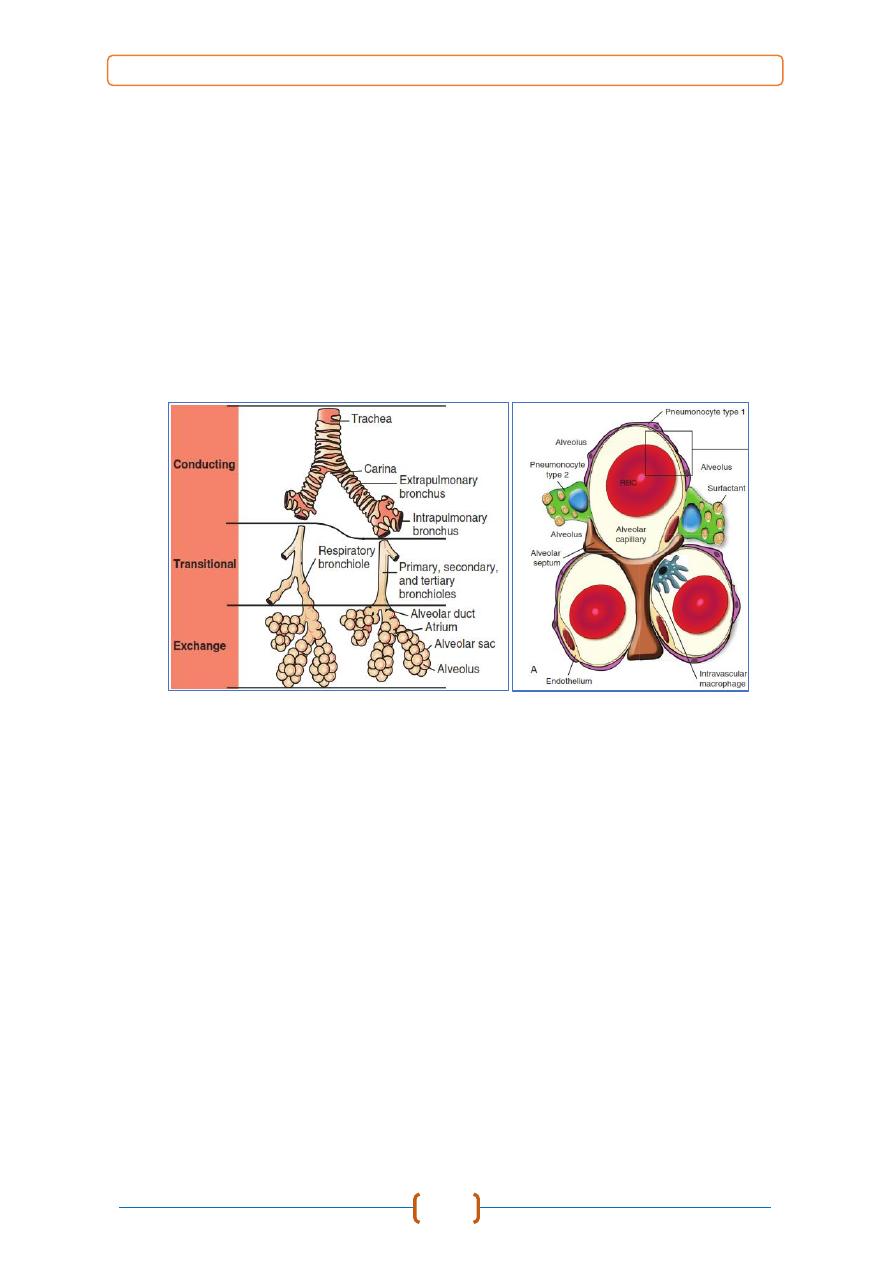
Pathology of Respiratory System/
2016 – 2017
/ Dr. Saevan S. Al-Mahmood
1
Histology and Functions of The Respiratory Tract
The respiratory tract divided into three continuous parts:
1- Conducting system: includes nasal cavity, sinuses, larynx, trachea and
bronchi. The mucosa is lined primarily by ciliated epithelium and goblet cells.
2- Transitional system: is formed by bronchioles that are lined by a specialized
mucosa containing several types of ciliated and secretory cells as Clara cells.
Unlike conducting system, normal bronchiolar mucosa contains no goblet cells.
3- Exchange system: This system is composed of the alveoli that are lined
externally by epithelial cells called pneumonocytes.
The type I (membranous)
pneumonocytes
are thin cells and together with the capillary endothelium and
basement membrane constitute the air-blood barrier.
Type II pneumonocytes
are
cuboidal and produce surfactant.
Addition to gas exchange, the respiratory system is involved in:
Phonation, Temperature regulation, Blood pressure regulation, Olfaction,
Detoxification (Clara cells).
Normal Flora of The Respiratory Tract
The types of bacteria present in the nasal flora vary considerably among
animal species. Some types of bacteria in the nasal flora are the same pathogens
associated with respiratory infections. Mannheimia (Pasteurella) haemolytica is
part of the bovine nasal flora, yet this bacterium causes a devastating disease in
cattle known as
Shipping Fever
. Microorganisms from the nasal flora are
continuously carried into the lungs via the tracheal air.
Defense Mechanisms
The most important defense mechanisms against inhaled particles are:
1-Air Filtration (bronchial bifurcation, turbulences, mucus, coughing).
2-Mucociliary clearance at conducting system.
3-Phagocytosis by alveolar macrophages at exchange system alveoli.
4-Innate and acquired immunity.

Pathology of Respiratory System/
2016 – 2017
/ Dr. Saevan S. Al-Mahmood
2
I- Pathology of Conducting System
1- Nasal Passages:
A- Nasal Cavity:
Nasal hemorrhage (Epistaxis and Hemoptysis):
Epistaxis
is nose bleeding, while
Hemoptysis
is blood in mouth, saliva or
sputum, they are common findings in all species. Epistaxis or hemoptysis do not
necessary imply that the hemorrhage has occurred in the nasal or oral mucosa
since both conditions can also be caused by pulmonary hemorrhage.
Epistaxis
is a common problem in all animal species as a result of trauma,
foreign body, nasal neoplasia, pulmonary hemorrhage. Epistaxis is commonly
seen in
HORSES
with:
1- Exercise induced pulmonary hemorrhage.
2- Guttural pouch mycosis.
3- Ethmoidal hematoma.
4- Nasal cysts.
B- Nose and Sinus:
Rhinitis
is inflammation of nose clinically characterized by nasal discharge
(unilateral or bilateral), and its most common type is
Allergic rhinitis
seen as
sporadic cases in dogs, cats, cattle and horses, while
Parasitic rhinitis
most
commonly seen in sheep infested by Oestrus ovis.
Sinusitis
is inflammation of paranasal sinus which manifested as uni or
bilateral nasal discharge. Unlike nasal cavity, paranasal sinuses have poor
drainage so exudate tends to accumulate and cause
sinus mucocele
which is
accumulation of mucus and fluid in paranasal sinus, or
sinus empyema
define as
accumulation of pus in paranasal sinus. In sheep,
Parasitic sinusitis
is commonly
caused by Oestrus ovis.
C- NASAL POLYPS
Nasal polyps are inflammatory condition of respiratory mucosa resembling
neoplastic growth caused by fungus and characterized by formation of new
growth of benign neoplasm in nasal passage.
Etiology:
Rhinosporidium sceberi fungus.
Grossly:
nasal polyp appears as pedunculated, elongated, cauliflower like growth
filling nasal cavity cause bleeding.
Microscopic lesion:
characterized by fibrous membrane cover mucosa layer with
heavily infiltration of neutrophils, lymphocytes, eosinophils, and macrophages
around fungal colonies.

Pathology of Respiratory System/
2016 – 2017
/ Dr. Saevan S. Al-Mahmood
3
D- Tumors of Nasal Passages
Epithelial tumors
of the nasal passages include adenomas (benign and rare)
and carcinomas (malignant and common).
Mesenchymal tumors
more common included fibrosarcoma, osteosarcoma
and chondrosarcoma.
Endemic Nasal Carcinoma (Endemic Ethmoidal Tumor)
Is a retroviral-induced neoplasia in sheep, goats and cattle with nonspecific
clinical signs but only hemorrhage, tumor often becomes infected with bacteria
causing mucopurulent nasal discharge with exophthalmia and craniofacial
deformation, with metastasis to brain causing nervous signs.
2- Guttural Pouches:
There are some important anatomical differences in domestic animals (i.e.,
syrinx in birds and guttural pouches in horses).
Guttural pouches
are ventral
diverticula of Eustachian tubes in horses located between pharynx to middle ear.
Guttural Pouch Empyema
accumulation of pus in equine guttural pouches which
is a common and important disease caused by pyogenic bacteria such as
Streptococci spp. characterized by accumulation of purulent exudates in
guttural pouches.
Guttural pouch mycosis
It is an important and occasionally fatal disease of horses
caused by Aspergillus spp. The sequel includes erosion of carotid artery,
massive nasal bleeding and cerebral infarcts. The gross lesions composed from
plaques of fibrinonecrotic exudate in guttural pouches.
3- Larynx
Necrotic Laryngitis (Calf diphtheria)
Important secondary infection caused by Fusobacterium necrophorum that
typically occurs following trauma or viral infection. Lesions composed from
fibrinonecrotic exudate on top of deep ulcers.
4- Trachea
Trachitis
Inflammation of trachea. In canines it is tracheobronchitis, in poultry it is
laryngotracheitis.
Etiology:
1- Canine tracheobronchitis caused by adenovirus and herpes virus.
2- Avian infectious laryngotracheitis (ILT) is caused by herpes virus.
Gross lesions:
1- Congestion of trachea and presence of catarrhal exudate in dogs.
2- In poultry hemorrhage and caseous plug in trachea towards larynx.

Pathology of Respiratory System/
2016 – 2017
/ Dr. Saevan S. Al-Mahmood
4
Microscopic features:
1- Inclusion bodies in tracheal and bronchial epithelium in canines with
Hemorrhagic tracheitis.
2- Presence of intra nuclear basophilic inclusions in tracheal epithelial cells in
infectious laryngotracheitis.
5- Bronchi
Bronchitis
Bronchitis is the inflammation of bronchi, characterized by
catarrhal
,
suppurative
,
fibrinous
or
hemorrhagic
exudate.
Etiology:
1- Bacteria e.g. Pasteurella.
2- Virus e.g. Infectious bronchitis in poultry.
3- Parasites.
4- Allergy/ Inhalation of pollens.
Macroscopic features:
1- Mucous exudate in lumen.
2- Congestion and hemorrhages in bronchi.
3- Presence of caseaous plugs at the point where bronchi enter in lungs.
Microscopic features:
1- Mucous exudate along with inflammatory cells in the lumen of bronchi.
2- Hyperplasia and/or necrosis of bronchiolar epithelial cell.
3-Accumulation of mononuclear cells in bronchial mucosa.

Pathology of Respiratory System/
2016 – 2017
/ Dr. Saevan S. Al-Mahmood
5
II- Pathology of the Transitional Systems (Bronchioles)
Unlike bronchi, the walls of the bronchioles do
NOT
contain cartilage and
mucosa does not normally have goblet cells. The pseudo-stratified epithelium in
bronchi gradually flattens and loses their cilia in bronchioles.
Heaves
Chronic Obstructive Pulmonary Disease (COPD)
Recurrent Airway Obstruction (RAO)
Important equine disease where the pulmonary lesions are centered in the
bronchioles. Mild injury and recurrent inflammation induces goblet cell
metaplasia in bronchioles. Goblet cell metaplasia causes accumulation of mucus
in the bronchioles that cannot be cleared by mucociliary movement. Bronchioles
plugged with mucus have airflow impairment and eventually leads to alveolar
emphysema. Abnormal respiration in affected horses causes hypertrophy of the
abdominal muscles which is clinically referred to as
heave line
.
Gross lesions
are
not remarkable except emphysema.
Microscopically
there is bronchiolar goblet
cell metaplasia and extensive mucus obstruction of small airways (bronchioles).
COPD with similar bronchiolar changes are typically found in chronic
smokers.

Pathology of Respiratory System/
2016 – 2017
/ Dr. Saevan S. Al-Mahmood
6
III- Pathology of The Exchange Systems
Lungs generally are:
-There are notable differences in lung morphology among animal species; i.e.,
equine poorly defined pulmonary lobes; bovine and canine well defined lobes.
-Pulmonary lobes are:
cranial
lobes,
middle
lobes and
caudal
lobes.
-Pulmonary lobes are subdivided into lobules by interlobular septa.
-Lobules are prominent in bovines and pigs, poorly defined in horses and man,
and absent in dogs and cats.
Alveoli are covered by:
Type I pneumonocytes
(membranous); interposed occasionally with type II
pneumonocytes (granular pneumonocytes). Type I pneumonocytes are notably
slender and particularly susceptible to injury.
Type II pneumonocytes
produce important phospholipids known as
pulmonary
surfactant
. This surfactant prevents alveolar collapse during respiration.
Necrotic pneumonocytes type I are replaced by type II which eventually
differentiate into type I.
Abnormal deposition of particles in Lung
1-Pneumoconiosis
is a general term used to describe pulmonary diseases
characterized by deposition of inhaled particles in the lung with in
granulomatous lesion. The most common particles are silica (silicosis) and
asbestos (asbestosis).
2-Anthracosis
is sporadically seen in domestic animals, particularly dogs,
exposed to carbon particles suspended in the air. Lungs have focal areas of black
discoloration. It is considered an incidental finding.
Pulmonary Edema
Pulmonary edema characterized by accumulation of fluid in interstitium and
alveoli. Generally, it's not a specific lesion, seen in many pulmonary, cardiac and
neurological diseases and it is the terminal cause of death for many illnesses.
Pathogenesis of lung edema
Normal lung produces fluid (transudate) that is rapidly removed by the
lymphatic system. When fluid production exceeds lymphatic removal, pulmonary
edema may rapidly follow.
1-Increased hydrostatic pressure (cardiogenic edema)
is commonly seen in
animals with left heart failure. Left heart failure causes pulmonary congestion
and then intra-alveolar hemorrhages that result in the formation of
heart failure
cells
in the lung. The edematous fluid in a cardiogenic edema usually has low
protein content.
2- Increase vascular permeability (permeability edema)
is seen when there is
injury to the air-blood barrier by toxic gases, inflammation, allergies and

Pathology of Respiratory System/
2016 – 2017
/ Dr. Saevan S. Al-Mahmood
7
pancreatitis. The edematous fluid in a permeability edema has usually high
protein content.
3- Obstruction to lymphatic drainage (obstructive edema)
, when lymphatic
vessels are closed by neoplasia involving thoracic lymphatic nodes. Edematous
fluid has usually low protein content.
Gross lesions of lung edema:
1- Foamy fluid in conducting system.
2- The lungs appear wet, heavy and fail to collapse when the thorax is opened.
Histopathology of lung edema:
1-Alveoli are flooded with fluid.
2- In permeability edema the fluid is generally rich in protein (eosinophilic) while
in cardiogenic edema the fluid is pale and difficult to see microscopically.
Atelectasis
Atelectasis is the failure of alveoli to open or the alveoli are collapsed and
thus do not have air.
Etiology:
1- Obstruction in bronchi/ bronchiole.
2- Inflammation of pleura.
3- In new born animals lungs.
Macroscopic features
1- Dull red in color, hard area of lung like liver in consistency.
2- Atelectic lung sinks in water.
Microscopic features
1- Compressed alveoli.
2- Absence of air spaces.
3- Collapsed bronchioles.
4- In inflammatory condition, exudate compresses alveoli.
Emphysema
Emphysema is the increase in amount of air in lungs characterized by
dilation of the alveoli. It may be acute or chronic and focal or generalized.
Etiology
1- Bronchitis.
2- Pneumonia.
3- Allergy to dust, Pollens.
Macroscopic features
1- Lungs are enlarged and flabby.
2- Imprints of ribs can be seen.
3- Color of lungs becomes pale.
4- Cut surface is smooth and dry.
Microscopic features
- Alveoli are distended. Some alveoli may rupture and form giant alveoli.
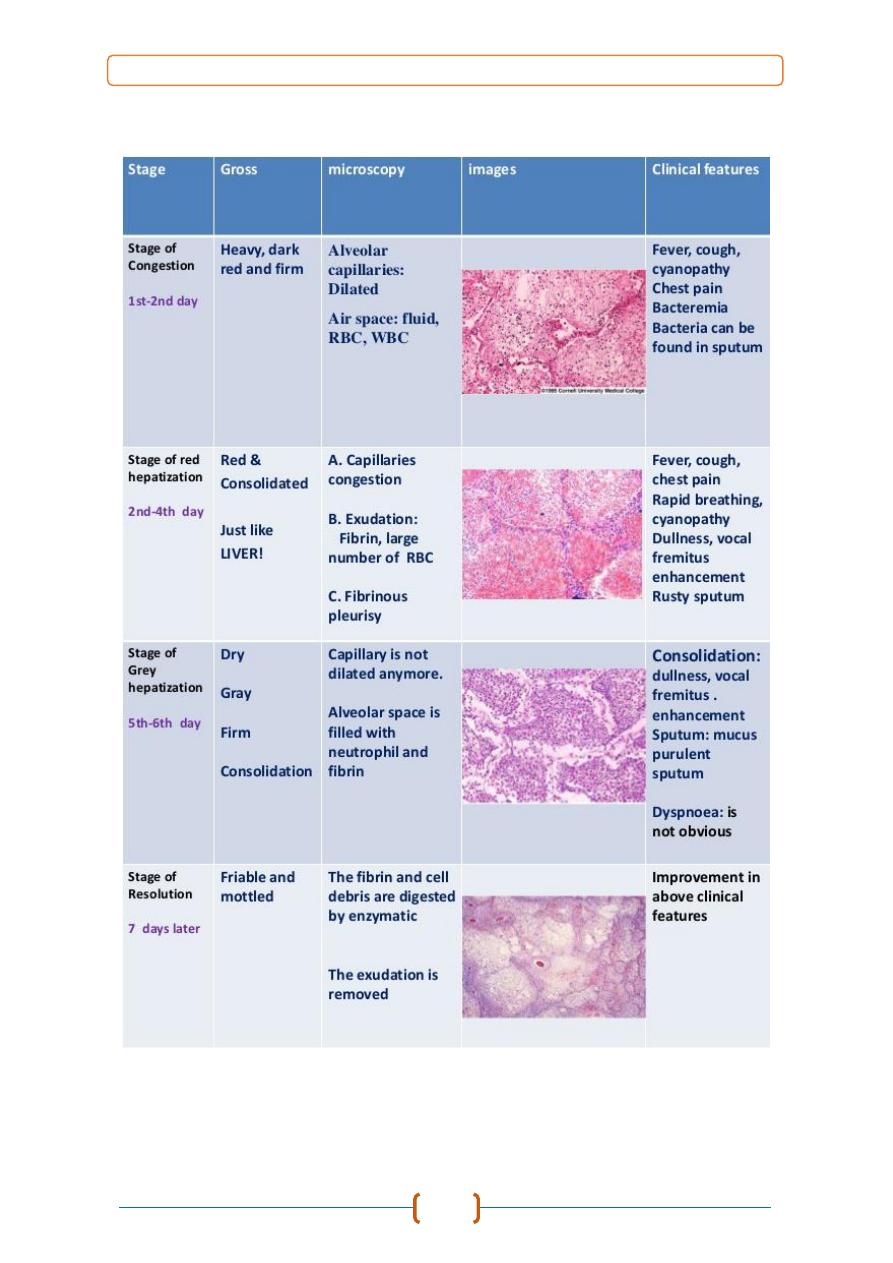
Pathology of Respiratory System/
2016 – 2017
/ Dr. Saevan S. Al-Mahmood
8

Pathology of Respiratory System/
2016 – 2017
/ Dr. Saevan S. Al-Mahmood
9
IV- Pathology of Lung
Pneumonia
Pneumonia is the inflammation of lungs characterized by congestion and
consolidation of lungs. The stages of pneumonia are as followed:
1- Consolidation
: Characterized by active hyperemia and pulmonary edema. The
capillaries are distended with engorged blood and alveoli are filled with watery
serous exudate.
2- Red hepatization:
Characterized by consolidation of lungs due to congestion.
The lungs are firm and looking like liver. Alveoli are filled with serous or
serofibrinous exudate giving hardness to lungs. In inflammatory condition, the
neutrophils, macrophages and lymphocytes along with erythrocytes infiltrate the
affected area of lungs.
3- Grey hepatization:
The lung remains hard but due to lysis and removal of
erythrocytes, it becomes grey in color. There is increase in infiltration of
inflammatory cells like macrophages, lymphocytes, epithelioid cells depending
on the type of etiological agents.
4- Resolution:
The recovery starts in form of resorption of fluid; removal of
autolyzed cells and debris by phagocytic cells. The causative organism is
neutralized or removed from the lungs through immunity of body. After few
days the lung parenchyma becomes normal and starts functioning. If the
causative agent is more virulent, it may cause death of animal due to respiratory
failure or may cause permanent lesions like formation of scar, cornification,
granuloma.
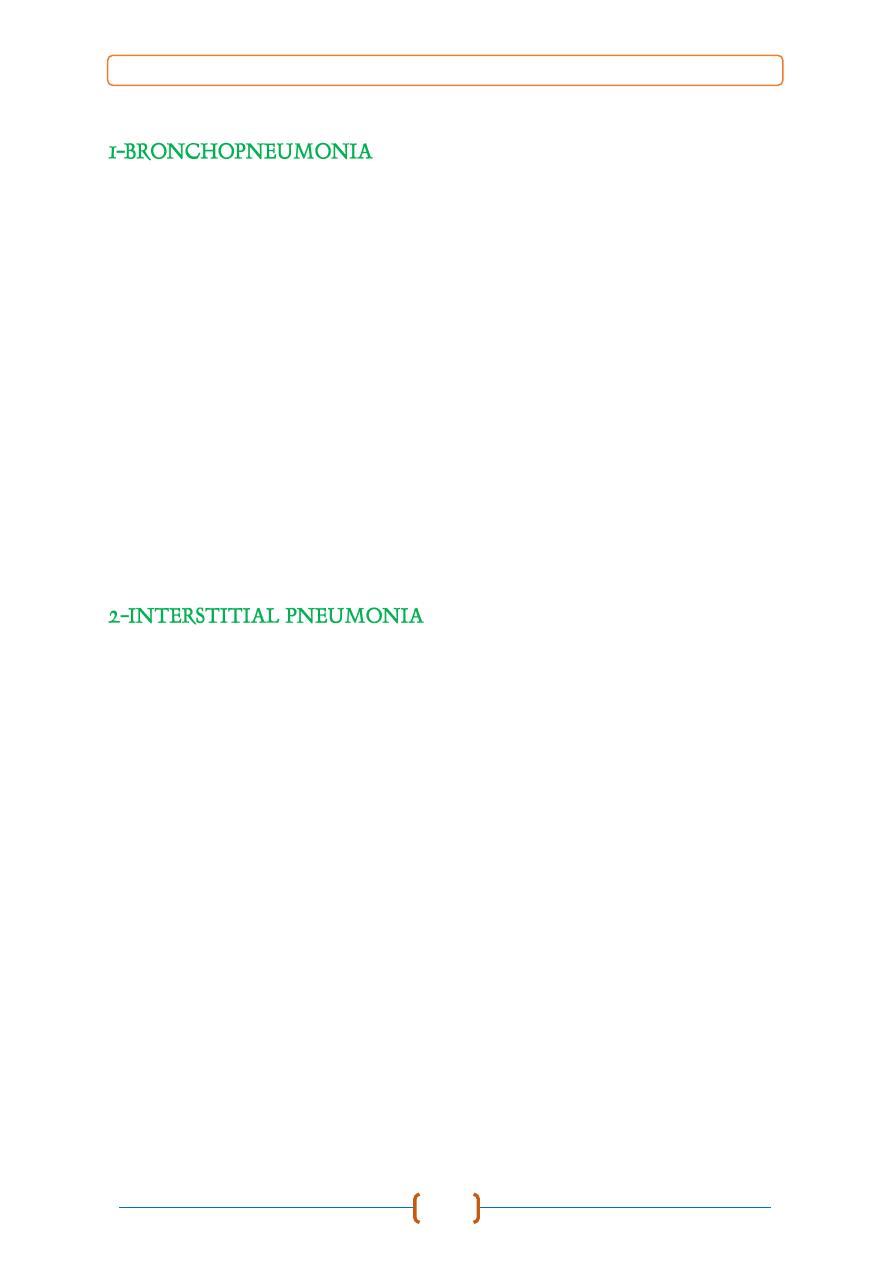
Pathology of Respiratory System/
2016 – 2017
/ Dr. Saevan S. Al-Mahmood
10
Type of Pneumonia
Bronchopneumonia is the inflammation of lungs involving bronchi or
bronchioles along with alveoli. It is thought to be spread through bronchogenous
route and is the common type of pneumonia in animals.
Etiology
1- Virus, Bacteria, Chemicals, Mycoplasma, Chlamydia, Parasites, Fungus.
2- Mainly through bronchogenous route.
Macroscopic lesions:
1- Congestion and consolidation of anterior and ventral parts of lungs.
2- Patchy lesions on one or several lobes and adjacent area shows emphysema.
3- Mediastinal lymph nodes are swollen.
Microscopic lesions:
1- Congestion, edema or hemorrhage in lung.
2- Infiltration of neutrophils and mononuclear cells in and around bronchioles
and bronchi.
3- Catarrhal bronchitis.
4- Proliferation of bronchiolar epithelium.
Interstitial pneumonia is the inflammation of the lungs characterized by
thickening of alveolar septa due to serous or fibrinous exudate along with
infiltration of neutrophils and/or mononuclear cells with proliferation of
fibroblasts. It is also known as lobar pneumonia.
Etiology
1- Bacteria, Virus, Chlamydia, Parasites.
2- Mainly through hematogones route.
Macroscopic lesions:
1- Lungs are pale or dark red in color.
2- Edema, dripping of fluid from cut surface
Microscopic lesions:
1- Alveoli may have serous or fibrinous exudate.
2- Thickening of alveolar septa due to accumulation of exudate, inflammatory
cells and in chronic cases, proliferation of fibrous tissue.
3- Infiltration of mononuclear cells in alveolar septa.
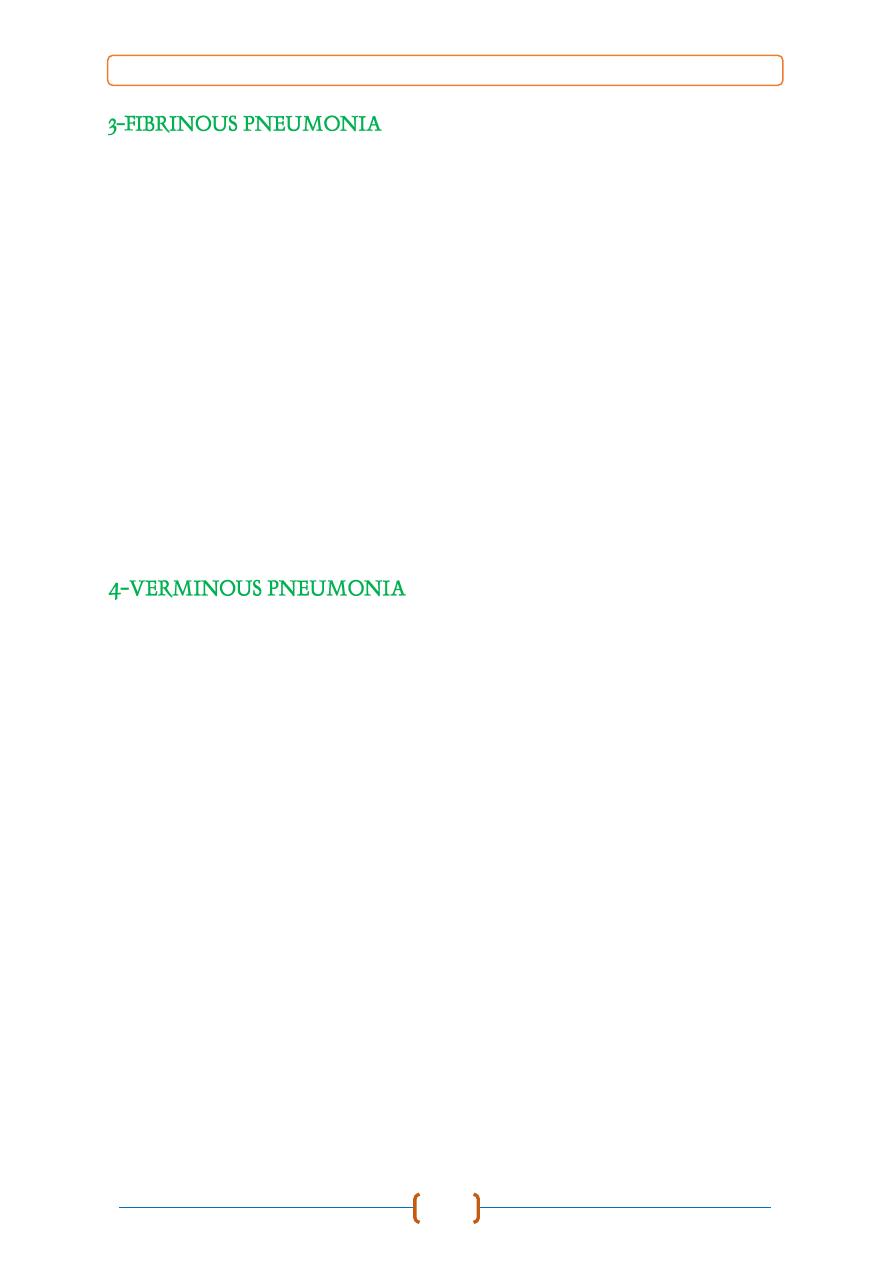
Pathology of Respiratory System/
2016 – 2017
/ Dr. Saevan S. Al-Mahmood
11
Fibrinous pneumonia is the inflammation of lungs characterized by the
presence of fibrin in alveoli or bronchioles and may give rise to hyaline
membrane formation (Diphtheric) over the surface of alveoli or bronchiole.
Etiology:
- Bacteria, Virus, Parasites, Toxin, Poisons.
Macroscopic lesions:
1- Antero-ventral portion of lung is congested and consolidation.
2- Color of lungs become deep red due to congestion.
3- Surface of lungs is covered by fibrin sheet.
4- Interlobular septa are prominent due to accumulation of plasma and fibrin.
Microscopic lesions:
1- Principal exudate is fibrin, fills alveoli, bronchioles and bronchi.
2- Congestion and/or hemorrhages.
3- Infiltration of neutrophils, macrophages and giant cells.
4- Formation of eosinophilic false membrane of fibrin over the surface of alveoli
and bronchiole and then known as “
hyaline membrane pneumonia
”.
Verminous pneumonia is caused by parasites and characterized by the
presence of lesions of bronchopneumonia along with parasites or their larva.
Etiology:
1- Metastrongylus apri in pig.
2- Dictyocaulus filariae in sheep and goat.
3- Dictyocaulus viviparus in cattle and buffaloes.
4- Dictyocaulus arnfieldi in horse and donkeys.
5- Capillaria aerophila in dogs and cats.
Macroscopic lesions:
1- Multiple petechial hemorrhage in lungs at the site of parasite penetration.
2- Mature worms in alveoli, bronchioles and bronchi.
3- Mucopurulent exudate in alveoli, bronchi.
4- Pulmonary edema, emphysema.
Microscopic lesions:
1- Dilation of bronchiole or bronchi.
2- Lesions of chronic suppurative bronchiolitis.
3- Focal areas of inflammation in vicinity of parasites and around bronchioles.
4- Hyperplasia of bronchiolar epithelium.
5- Infiltration of eosinophils and lymphocytes.
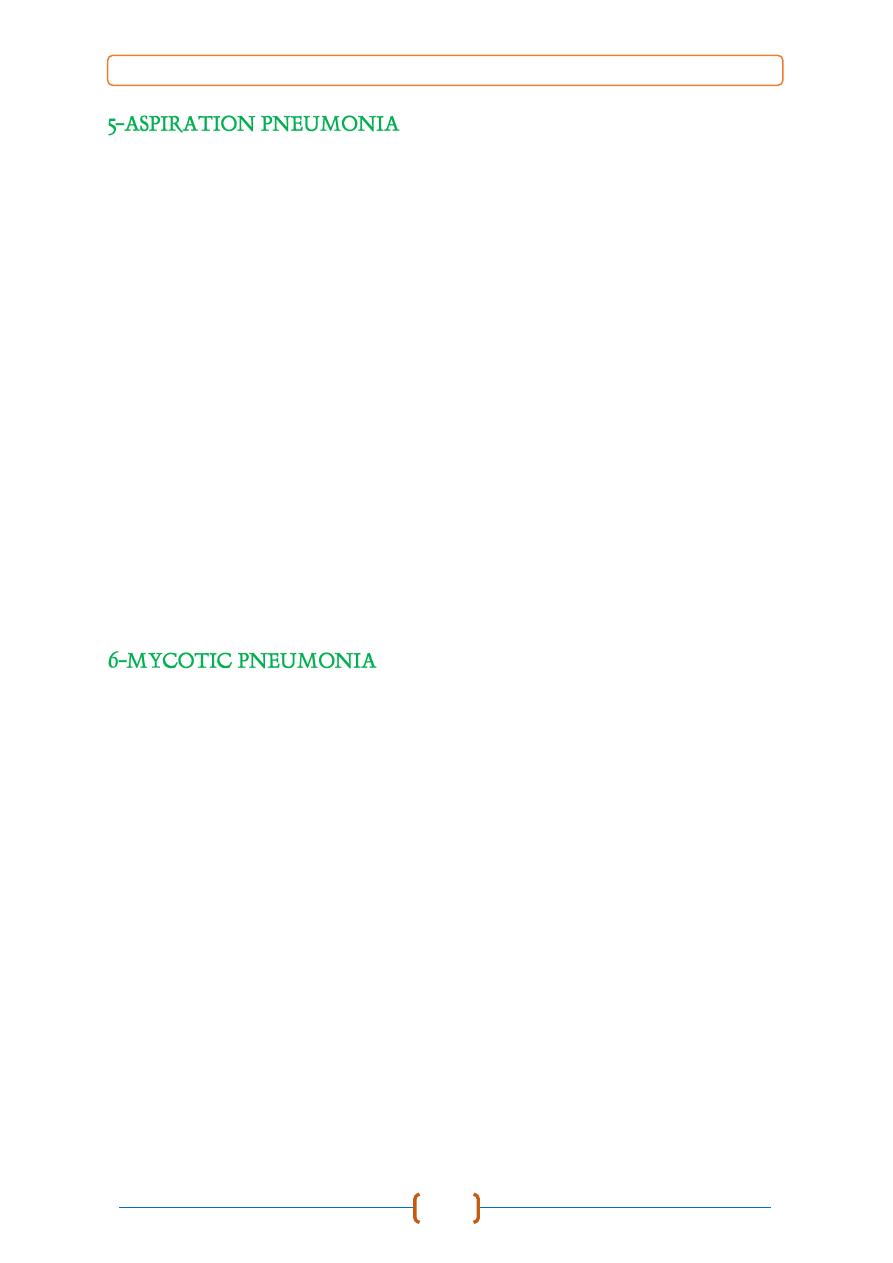
Pathology of Respiratory System/
2016 – 2017
/ Dr. Saevan S. Al-Mahmood
12
Aspiration pneumonia is caused by faulty medication through drenching
which reaches in lungs instead of target place and characterized by necrosis and
gangrene of lung parenchyma.
Etiology:
1- Drugs, food, foreign body and oil which reaches in lungs through trachea.
2- Paresis of throat predisposes the animal for aspiration pneumonia.
Macroscopic lesions:
1- Congestion and consolidation of anterior and ventral portion of lung.
2- Affected part becomes green/ black in color, moist gangrene.
3- Affected lungs are often foul smelling.
4- Presence of foreign body like wheats, corn, oil.
Microscopic lesions:
1- Thrombosis of blood vessels.
2- Necrosis in lungs.
3- Presence of saprophytes and leucocytes cause liquefaction and gangrene.
4- Gangrenous lesions surrounded by intense inflammation.
Mycotic pneumonia is caused by a variety of fungi and characterized by the
presence of chronic granulomatous lesions in lungs.
Etiology:
1- Aspergillus fumigatus.
2- Blastomyces sp.
3- Cryptococcus sp.
4- Coccidioidomyces immitis.
Macroscopic lesion:
1- Nodules in lungs
2- On cut, cheese like caseated mass in nodules.
3- Caseation involves both bronchiole and alveoli.
4- Such lesions may also present in trachea and air sacs.
Microscopic lesions:
1- Presence of granulomatous lesions i.e. caseated necrosis, macrophages,
epithelioid cells, lymphocytes, giant cells, fibroblasts.
2- Presence of branched hyphae of fungi in the necrotic area.
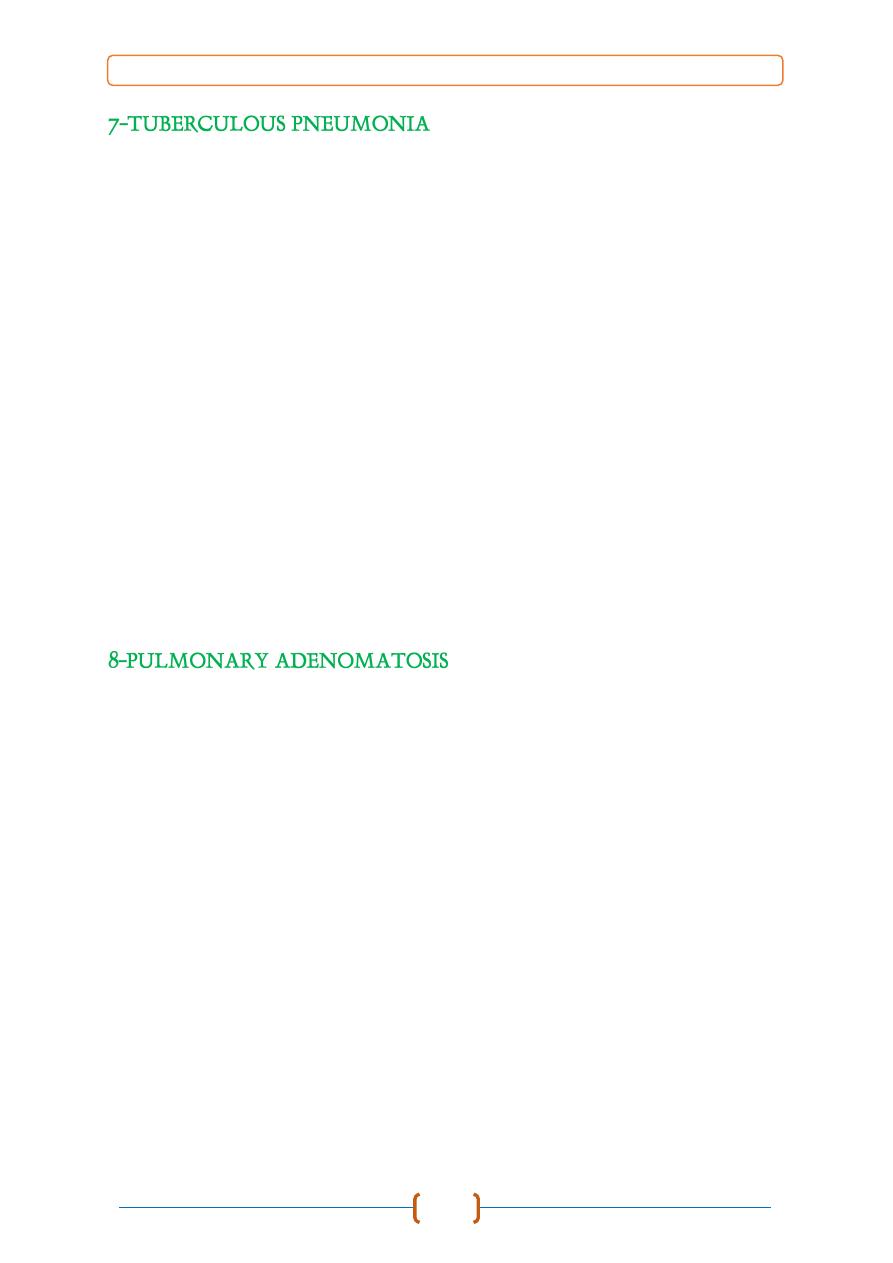
Pathology of Respiratory System/
2016 – 2017
/ Dr. Saevan S. Al-Mahmood
13
Tuberculous pneumonia is caused by Mycobacterium sp. and characterized
by presence of chronic granulomatous lesions in lungs.
Etiology
1- Mycobacterium tuberculosis.
2- Mycobacterium bovis.
Macroscopic features
1- Grey, white or light yellowish nodules in lungs.
2- Nodules are hard, painful and/or calcified.
3- Animal carcass is emaciated.
4- On cut, the cheesy material present in nodules.
Microscopic features
1- Presence of tubercle (granuloma) in lungs which comprises a central necrotic
area surrounded by macrophages, epithelioid cells, lymphocytes, Langhan’s
giant cells and covered by fibrous covering.
2- Acid-fast rod shaped bacteria present in necrotic area.
3- Central area may be calcified.
Pulmonary adenomatosis is a slow viral disease of sheep, characterized by
metaplasia of alveolar squamous epithelium to cuboidal and /or columnar
epithelium leading to glandular appearance of alveoli.
Etiology
1- Retrovirus.
2- Pulmonary adenomatosis virus.
Macroscopic features
1- Multiple focal areas of consolidation in lungs.
2- Imprint of ribs on lungs.
3- Congestion and hardening of mediastinal lymph nodes.
Microscopic features
1- Metaplasia of alveolar epithelium leading to formation of glandular structures
in alveoli, this metaplasia of simple squamous epithelium to cuboidal or
columnar epithelium which gives alveoli a gland like look.
3- Mild inflammatory reaction.
4- Proliferation of fibrous tissue.

Pathology of Respiratory System/
2016 – 2017
/ Dr. Saevan S. Al-Mahmood
14
Hypersensitivity pneumonia inflammation of lung caused by an allergic
reaction of antigen characterized by interstitial pneumonia, emphysema, hyaline
membrane formation and hyperplasia of alveolar epithelium.
Etiology
1- Allergens.
2- Parasites.
3- Aspergillus sp.
Macroscopic features
1- Lobes may contain small grey foci.
2- Presence of yellow and dense mucus in lumen of bronchi.
3- Excessive accumulation of air in lungs due to emphysema.
4- Presence of adult worms and larvae.
Microscopic features
1- Extensive infiltration of lymphocytes, monocytes and eosinophils around
bronchi and bronchioles.
2- Accumulation of catarrhal exudate in bronchi or bronchiole.
3- Emphysema as a result of widening of alveoli.
4- Hyperplasia of bronchiolar musculature.
5- Inflammatory cells in interalveolar septa may form small granulomas.
6- Formation of hyaline membrane over alveolar and bronchiolar epithelium.
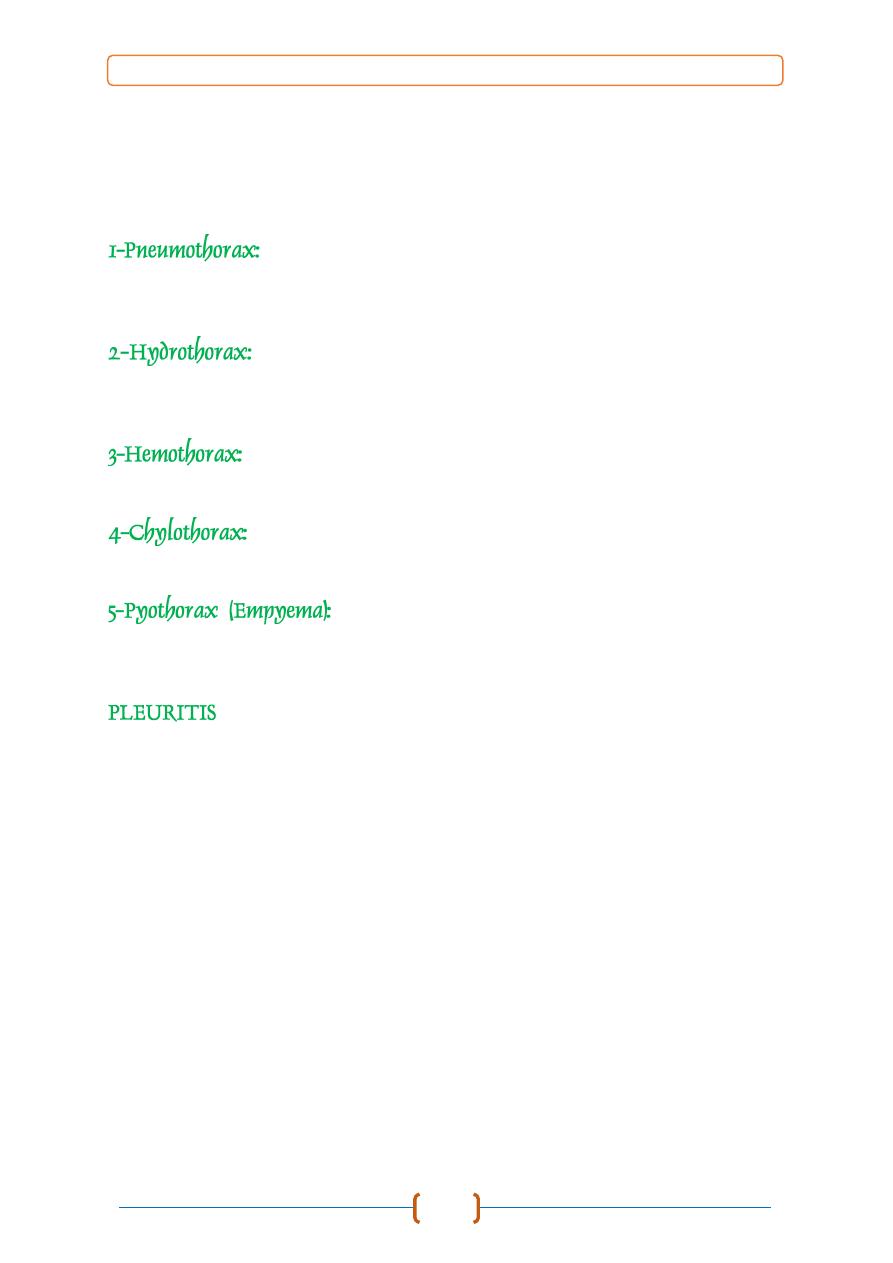
Pathology of Respiratory System/
2016 – 2017
/ Dr. Saevan S. Al-Mahmood
15
V- Pathology of Thoracic cavity
The thoracic (pleural cavity) is lined by the parietal pleura (ribs, diaphragm
and mediastinum) and the visceral pleura (lungs). Under normal conditions once
the cavity has been opened, the lungs appear smaller in comparison to the rest of
the cavity.
Pneumothorax is the presence of air in the thoracic cavity (loss
of negative pressure). It is caused by trauma, rupture of lung or rupture of
esophagus (gas in mediastinum), iatrogenic (i.e. biopsy). Gross lesions: failure
of diaphragm to retract, atelectasis.
Hydrothorax is accumulation of abnormal quantities of
transudate (serous fluid) in thoracic cavity. Common causes of hydrothorax
include congestive heart failure, hypoproteinemia and lymphatic obstruction.
Lesions: fluid in cavity.
Hemothorax is presence of free blood in thoracic cavity. It is
caused by severe trauma or penetrating wound into lungs, rupture of major blood
vessels (aneurism), warfarin poisoning.
Chylothorax is presence of free lymph in thorax and it is caused
by rupture of a major lymphatic duct. Most common causes are thoracic trauma,
iatrogenic (surgery) and neoplasia. Lesions: Milky fluid in cavity.
Pyothorax is accumulation of purulent exudate in
thoracic cavity. In cats, it is commonly produced by Pasturella multocida, in
dogs by Nocardia asteroides and in horses by Streptococcus or Mycoplasma.
Pleuritis is the inflammation of pleura characterized by serous, fibrinous or
purulent exudate. It is also known as
pleurisy
.
Etiology
1- Mycobacterium tuberculosis.
2- Mycoplasma mycoides.
3- Haemophilus suis.
4- Organisms responsible for pneumonia or traumatic pericarditis.
Macroscopic lesions:
1- Congestion of pleura, hemothorax, and chylothorax.
2- Serous, fibrinous or purulent exudate.
3- In chronic cases there is adhesive pleuropneumonia.
Microscopic lesions:
1- Congestion of blood vessels.
2- Infiltration of neutrophils and lymphocytes.
3- Thickening of pleura due to edema and infiltration of inflammatory cells.
4- Proliferation of fibroblasts producing adhesive lesions.

Pathology of Respiratory System/
2016 – 2017
/ Dr. Saevan S. Al-Mahmood
16
1- Primary Lung Tumors
Primary epithelial lung tumors:
- Adenoma / papilloma (benign).
- Squamous cell carcinoma, adenocarcinoma (malignant).
Primary mesenchymal lung tumors:
- Hemangioma or hemangiosarcoma.
- Fibroma or fibrosarcoma.
2- Secondary (Metastatic) Tumors in Lungs
More common than primary lung tumors. Lungs are highly vulnerable to
metastasis due to density of capillaries. Metastatic tumors are seen as multiple
nodules or masses with random distribution.
Common tumors that often metastasize to the lung:
1- Osteosarcoma, Chondrosarcoma, Fibrosarcoma.
2- Hemangiosarcoma, Lymphosarcoma.
3- Mammary carcinoma, Uterine carcinoma, Adrenal carcinoma.
